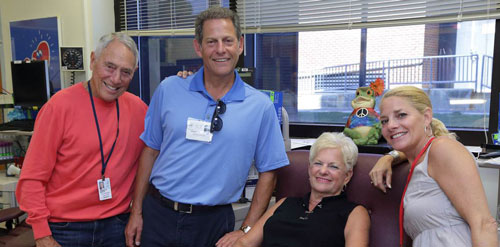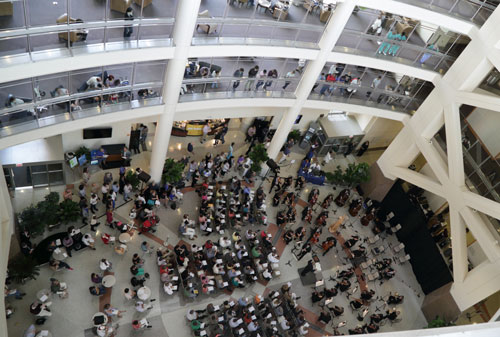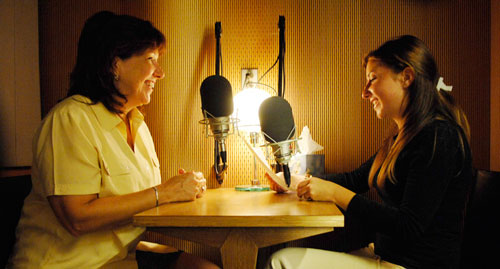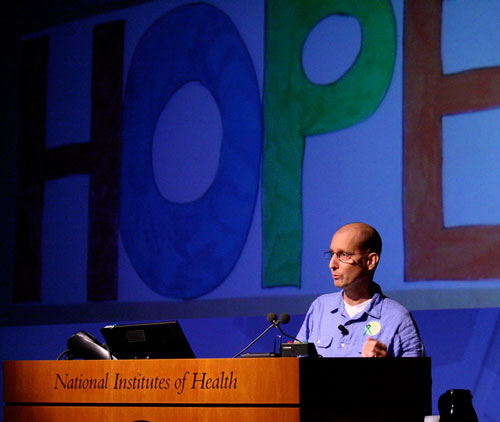

October 2014
IN THIS ISSUE:
![]()
- Distinguished Clinical Teaching Award presented to NIDDK doctor
- The 'NIH Bear' asks you to help foil the flu
- Two decades of donations
- The National Symphony Orchestra brings Sound Health
- NIH partners with StoryCorps, encourages volunteers to share stories of medical research
- NIH celebrates 20th anniversary of allogeneic stem cell transplants
- Ten years of CRIS
- A new dining approach begins on the second floor
- Clinical Fellows Day empowers scientists, aids career growth
- Upcoming Events
Print this Issue ![]() (449 KB)
(449 KB)
ABOUT CC NEWS:
![]()
Published monthly by the Office of Communications and Media Relations. News, article ideas, calendar events, letters, and photographs are welcome. Submissions may be edited.
Clinical Center News
National Institutes of Health
Building 10, 10 Center Drive
Room 6-2551,
Bethesda, MD 20892-1504
Tel: 301-594-5789
Fax: 301-402-0244
Molly.hooven@nih.gov
QUICK LINKS:
![]()
Distinguished Clinical Teaching Award presented to NIDDK doctor
 |
John I. Gallin, Clinical Center director, and Dr. Ranganath Muniyappa, the 2014 NIH Distinguished Clinical Teaching Award winner, join Clinical Fellow Committee members Drs. Syed Abbas Ali and Ricardo Correa. |
The 2014 NIH Distinguished Clinical Teaching Award was presented in September to Dr. Ranganath Muniyappa by the NIH Fellows Committee for his commitment to training clinical investigators at the NIH and overall contribution to medical education.
Muniyappa is a staff clinician at the National Institute of Diabetes and Digestive and Kidney Diseases. He focuses on the metabolic and vascular actions of insulin and how these actions are impaired in obesity, diabetes and cardiovascular disease.
The award was presented Sept.10 before the Grand Rounds Contemporary Clinical Medicine: Great Teachers Lecture in Lipsett Amphitheater.
This lecture series honors physician-scientists who are great teachers that inspire others and truly engage their students.
Prior to the presentation of the award, lecture attendees heard several clinical fellows testimonial that was included in their nomination of Muniyappa.
One clinical fellow said "[Muniyappa] continually encourages us to become exceptional clinicians and researchers. He spends time individually trying to understand our research interests, offering guidance and insight into how to best achieve our goals. He also demonstrates exceptional leadership as he guides how we should care for our patients during our diabetes clinic."
Another clinical fellow added, "Each patient is treated with compassion and care, as if they were his own family member. As I watch him interact with patients, I think to myself, yes, that is exactly how I want to be when I start practicing on my own."
The award was established in 1985. It's the highest honor bestowed on an NIH investigator, staff clinician or tenure-track investigator by the NIH Fellows Committee. The award recognizes nominees who mentor healthcare professionals, teach issues related to direct patient care and contribute to the advancement of clinical research. Those nominated for the award, in addition to Muniyappa include Drs. Ann Berger, Mark Hallett, Theo Heller, David Henderson, Shivaani Kummar, Karel Pacak, Anthony Suffredini, William Theodore, Cynthia Tifft and Michael Ward.
The 'NIH Bear' asks you to help foil the flu
 |
"The person who gave the shot was sweeter than honey!" said the NIH Bear as he received the vaccine. |
The annual flu immunization clinic will be open through Oct. 25 to employees and contractors with a valid NIH ID. In September, the 'NIH Bear' made his second appearance on campus just to get his flu shot. "It's not un-bear-able to get a flu shot! It feels grrreat to know that I'm helping protect myself, patients, staff and visitors this flu season," he said. "The seventh floor, where the shots are given, was a bit of a climb compared to my last visit, but it was over before I knew it; as quick as one, two, tree."
View the immunization schedule: www.foiltheflu.nih.gov.
Two decades of donations
NIH Blood Bank celebrates a donor's milestone of giving
 |
The Sachs family (Jerry, Gene, Joyce and Barb Brody) at the NIH Blood Bank. |
On Sept. 2 the NIH Blood Bank at the Clinical Center welcomed Joyce Sachs to their donor 'Hall of Fame.' Sachs, who has been donating for more than 25 years, recently gave her 100th blood donation. She has contributed to the welfare of about 200 patients.
"Once my husband became a patient at the NIH, I just decided it was something I could do regularly," Sachs said. "It was something that I could do to give back to people that didn't take very much time, and it didn't cost any money but it did a lot of good."
The people within the Clinical Center Department of Transfusion Medicine have played a key role in Sachs's deciding to return year after year.
"It's just beyond a wonderful thing how they make you feel, in addition to of course the benefits to the patients," Sachs said. "I happen to have a blood type that's not quite as normal as many other people. When you get [a phone call saying] 'We've got someone that really needs your blood,' boy you get right over there!"
Sachs, her family and staff celebrated the milestone together.
"We are truly appreciative of the decades-long dedication it takes to make such a contribution," said Hal Wilkinson, recruitment supervisor at the Clinical Center Department of Transfusion Medicine. "Joyce and the other women and men in the NIH Blood Donor Hall of Fame are to be commended for their service to our patients."
Despite the recognition, this won't be Sachs's last donation at NIH.
"I have all intentions of continuing my contributions," she said. "I'm not done because I hit 100!"
She has also passed down the family tradition of service to her daughter Barb Brody, seen in the photo above, who has donated 36 units of blood to date.
The National Symphony Orchestra brings Sound Health
 |
The event represented the National Symphony Orchestra's fifth visit to the NIH as part of the Sound Health initiative. |
The National Symphony Orchestra [disclaimer] performed Sept. 17 in the Clinical Center atrium as part of their Sound Health initiative.
The initiative, which launched one year ago with an inaugural concert in the Clinical Center, brings orchestral music to area hospitals and medical centers.
The event was co-presented by the Clinical Center and the Foundation for Advanced Education in the Sciences [disclaimer].
 |
The music travels up to the other floors in the Clinical Center for patients and staff to hear. |
NIH partners with StoryCorps, encourages volunteers to share stories of medical research
 |
StoryCorps participant photo courtesy of Tony Rinaldo. |
NIH's Office of Science, Outreach and Policy is launching an exciting project to capture the voices of medical research. The office has partnered with StoryCorps [disclaimer], a national oral history project, to give patients, their loved ones, researchers, staff and others in the community an opportunity to share their stories.
A StoryCorps interview is 40 minutes of uninterrupted time for meaningful conversation between two people who know each other well: two researchers, a patient and/or family member and researcher; family members of a patient, etc. Due to limited slots, StoryCorps may not be able to accommodate all volunteers.
The participants determine the conversation topics, but the goal is to capture stories that reflect different aspects of the NIH research experience. Some of these stories are edited into shorter segments, which may be shared with millions of Americans in a weekly, award-winning broadcast on NPR's Morning Edition and through the StoryCorps website and podcast.
StoryCorps will be on campus for three days this December. Participants will receive a copy of their recordings, which will also be archived at the American Folklife Center at the Library of Congress. Additionally, selected recordings will be turned into edited segments that will be integrated into the visitor experience at NIH, featured on the NIH website, and shared with broader communities through social media or played in media broadcasts, presentations, etc.
For more information or to request to participate email storycorps@nih.gov.
NIH celebrates 20th anniversary of allogeneic stem cell transplants
 |
Stem cell transplant survivors, including some individuals celebrating 20 years post-transplant, gathered in Masur Auditorium Sept. 12 after the survivorship program. |
The NIH Blood and Marrow Transplant Consortium held a two-day celebration of the 20th Anniversary of Allogeneic Stem Cell Transplants at NIH in September.
Over 600 scientists, nurses, healthcare providers, transplant survivors and caregivers attended interdisciplinary events held in the Clinical Center that touched on the successes and challenges facing allogeneic stem cell transplantation. During this type of transplant, a patient receives stem cells from a family member or donor that at least partly match the patient's cells. The procedure allows for the replacement of blood cells that are either not working properly or have been destroyed.
Twenty-two experts from the Clinical Center, National Cancer Institute, National Heart, Lung, and Blood Institute (NHLBI) and National Institute of Allergy and Infectious Diseases joined guest speakers from Vanderbilt University Medical Center and Memorial Sloan-Kettering Cancer Center to describe the current state of allogeneic stem cell transplantation. The Sept. 11 session covered stem cell donation and manipulation, transplantation in malignant and nonmalignant conditions, late effects and future directions.
Dr. John I. Gallin, director of the Clinical Center, opened the program.
"Innovations and treatments using allogeneic stem cells are one of the areas of emphasis at the NIH's clinical intramural program," said Gallin. "The improvements that have resulted from this program are continually succeeding, and we are proud of the work conducted here. This program has helped to contribute to the world effort."
The scientific day was described as innovative, extraordinary and groundbreaking by attendees. As each presenter spoke about specific diseases, syndromes and methods of research, there was an underlying message of the importance of the patients.
Dr. Henry Masur, chief of the Clinical Center Intensive Care Unit (ICU), summarized his presentation by saying, "As you look back at what's happened over the last 21 years, there have been remarkable advances in medicine which have facilitated improved survival for stem cell transplant recipients. It's wonderful to see patients come to the ICU who've had stormy courses and survive." Masur also lauded Dr. John Barrett, senior investigator in the stem cell allogeneic transplantation section of NHLBI, and his team for their leadership in advancing research on graft-versus-host disease.
Dr. Francis S. Collins, director of the NIH, applauded the scientific presentations and ongoing research and also previewed the importance of the following day's events.
"I want to particularly draw to your attention the opportunity to celebrate the lives of those who inspire this work more than any others the patients — who've received stem cell transplants here at the Clinical Center and have been followed ever since," said Collins. "The survivorship program will be a powerful representation of the importance of this work and how it has affected people's lives."
The second day of the event focused on the patient and caregiver perspective. It began with the dedication of a tree and a plaque outside the Clinical Center to recognize the NIH programs for their efforts in advancing science and transplantation.
 |
Allan De Luca speaks about his journey as a transplant survivor. |
A hundred patients, accompanied by family and caregivers, celebrated the scientific advances that they helped make a possible.
Allan De Luca, a transplant survivor, shared his journey of sorrow and joy with the crowd. He said his presentation in Masur Auditorium was a 'check off his bucket list,' and despite the topic at hand, he was able to bring the audience to a roar of applause and laughter throughout his speech.
De Luca was diagnosed with lymphoma and received his stem cells at the Clinical Center in 2009. "I was told back at home that there were no more treatment options and that I had about six months to live. Today is day 2,067 [post-transplant]," he said.
During his presentation, De Luca displayed a photograph of a poster his children made for his hospital room with the word hope.
"Hope played a pretty large part in just trying to get through every day. Before all this happened, I can't say that I really thought about the notion of hope. I never hoped I would be there for my kid's graduation. I just assumed I'd be there. Here at NIH, hope was rekindled. It was a chance perhaps to beat the odds. Somewhere along the lines, hope transitions to belief. The hope of getting things done morphs into actually believing that everything will work out."
De Luca faces many hurdles, but he doesn't have to do it alone. In addition to a support team at home, De Luca and all transplant survivors are regularly monitored as part of the NIH program.
"People often told me that I was courageous. But the truth of the matter is the courage wasn't mine," he said. "[It's the nurses who] choose to work here. The doctors who come here because that's what they want to do. The lab technicians that contribute to our well-being. The ladies in the library that'll bring you a book to your room. And all the other fantastic people here at NIH, from voucher to travel to nutrition. Thousands of people contribute to the standard of care and everyone plays a role in our story. For me, that's courage."
Ten years of CRIS
The electronic health record system continues to advance
The Clinical Research Information System (CRIS), the Clinical Center's electronic health record, hit its 10-year milestone! It was implemented Aug. 21, 2004 and replaced the Medical Information System (MIS) that had been used since 1976.
CRIS created a central place to store and find patient information and data, including medical orders, clinical documentation, medication administration history, protocol consents, diagnostic testing results and information from different departmental and institute systems. The system has helped to create a centralized electronic health record.
Over the last decade, CRIS has undergone four upgrades, with a fifth one in progress. In addition, over 25,000 system change requests have been documented and completed. This large volume of requests shows how easy it is for CRIS users to take advantage of the system's flexibility and to ask for custom changes. Important changes implemented include creating new order forms, adding a protocol order set or new order items, incorporating new clinical documents or new clinical decision alerts and making a new tab to view medications.
To celebrate CRIS's birthday, staff recalled the time when it launched and the significant roles it has played in everyday life at NIH.
"Our old nutrition department computer system couldn't accept diet orders electronically. Orders were printed out and manually entered into the system. When CRIS went live, it allowed [us] to have a diet order interface, which was a huge step forward. Clerks no longer had to enter diet changes manually. In addition to significant time savings, the switch was a big advance for patient safety, as it helped minimize order errors," said Madeline Michael, chief, Clinical Nutrition Services, Nutrition Department.
"Practitioners that utilize CRIS may not know that there was and still is great teamwork in building and maintaining CRIS. Departments other than DCRI help maintain CRIS. The ability to work [together] to create a tool that is useful and accurate is essential in having an electronic health record that is more than an electronic version of the paper record," said Dr. Jharana Tina Patel, quality assurance officer, Pharmacy Department.
"With CRIS you can see things as they evolve over the course of the day, like vital signs. You can see data from different hours and trends a lot better than before. You're able to see the information pretty much at your fingertips rather than having to go diving through the record and searching for a long time. We're also beginning to realize a lot more potential for the patients. [CRIS] gives the patients a more comprehensive record that is better to share with outside providers," said Kathy Feigenbaum, Clinical Nurse Specialist, Nursing Department.
"It was a huge change and was extremely exciting. It was totally different technology. During those ten years we've enhanced the sending and receiving of data to other systems both in the Clinical Center as well as other institutes and centers, so that the caregiver and the researcher have as much comprehensive information as possible. And we're still continuing to improve the value and quantity of the data in the system," said Sue Houston, Chief, Portfolio Office, Department of Clinical Research Informatics.
"The system has a part to play in supporting the research and in providing solutions for a very imaginative and thoughtful user group. It attempts to balance the clinical and the research needs of the diverse NIH Clinical Center user community. Sometimes those features and requirements are well aligned, and sometimes it takes some creative thought to put them together as a cohesive workflow," said Seth Carlson, Staff member, Department of Clinical Research Informatics.
A new dining approach begins on the second floor
 |
This is currently the only NIH dining location to offer such amenities. |
After weeks of renovation, the Clinical Center second floor cafeteria has reopened with a fresh new look and a better-balanced kitchen that creates greater awareness for diners through food choices, education, information and technology.
The information provided by the 'Balance Kitchen' has nutrient and ingredient information for menu items. It provides guests with the knowledge needed to make informed, healthful and sustainable choices.
Eurest, the dining service producer, integrated a sophisticated wellness program into the caf and installed new digital signs that can be changed daily, as well as electronic tablets that patients, staff and visitors can use to compare the nutritional value of various food options. After selecting certain food items on the menu, users can see the combined total nutritional value of those foods and can have that summary emailed to them. The menu for the days ahead can also be accessed on the tablet.
At the grand reopening celebration Sept. 15, guests enjoyed food samples and staff guided attendees through the new tablet options and amenities. View more information.
Clinical Fellows Day empowers scientists, aids career growth
 |
NIH clinical fellows join together with senior leadership from the Intramural Research Program during the second annual Clinical Fellows Day in the Clinical Center. |
On Sept. 8, nearly 80 clinical fellows from across the NIH attended the second annual Clinical Fellows Day to gain valuable career advice from the senior leadership of the NIH Intramural Research Program. They learned about developing new clinical research projects, supporting physician-scientist personal and professional development, enhancing the NIH knowledge base and understanding the spectrum of available opportunities in a clinical research career.
The event was organized with the support of the NIH Clinical Fellows' Committee, the Clinical Center's Office of Clinical Research Training and Medical Education and the Foundation for Advanced Education in the Sciences [disclaimer]. It was held in the Lipsett Amphitheater in the Clinical Center.
This was a day designed to "honor the past, celebrate the present and embrace the future" of clinical research, according to Drs. Sid Kerkar and Natalia Chalmers, co-chairs of the NIH Clinical Fellows' Com-mittee and co-organizers for the event.
The Clinical Fellows Day included a town hall discussion and informational sessions for clinical fellows to learn about CRIS improvements, the NIH researchers' collaboration network, pediatric clinical services and translator services at the hospital. Dr. John I. Gallin, director of the Clinical Center, provided important guidelines for fellows seeking careers in patient care and described the Clinical Center's goals for the next decade. Drs. Anthony S. Fauci, Garry H. Gibbons, Harold E. Varmus and Nora D. Volkow, the directors of the National Institute of Allergy and Infectious Diseases, National Heart, Lung, and Blood Institute, National Cancer Institute and National Institute on Drug Abuse were keynote speakers as well. Dr. Francis S. Collins, director of the NIH, shared stories from his own childhood and medical school days during his presentation.
"Those of us who have the opportunity to experience both the intensely personal challenge of patient care and the exultation of scientific advance are among the luckiest of all human beings," Collins said, citing a paper he had written as a graduation speaker at Yale University in 1990.
Fellows felt encouraged throughout the day and thankful for the occasion to meet peers, colleagues and NIH senior leadership.
"This opportunity to listen to some of the most brilliant clinician-scientists at NIH discuss their early career experiences and the opportunity to spend unhurried time with co-fellows from departments I never see during my clinical duties has been a highlight of my fellowship time at NIH. I feel valued!" said Brooke Decker, a clinical fellow with the Critical Care Medicine Department and administrative secretary for the NIH Clinical Fellows' Committee Executive Board.
David Chasca, a clinical fellow with the National Institute of Diabetes and Digestive and Kidney Diseases, also enjoyed the event.
"It built a sense of camaraderie," he said. "It made me realize how many physician scientists I'm traveling with as we embark on the beginnings of greatness, directed by the master educators who guide us."
View more details on NIH Clinical Fellows.
Upcoming Events
 |
Before the celebratory week the following PAs gathered for a photo at the Clinical Center. Back row: Megan Putman, George Carter, Justin Rodante. Third row: Merate Legesse, Tiffani Taylor, Lee England. Second row: MLou Stevens, Janet Valdez, Rena Godfrey, Catherine Vangellow. Front: Nicola Dee, Elise Ferr, Richard Kwan. Not pictured: John Hubbard, Kathy Lightfoot-Johnson, Cornel Rogers, Nana Yaqub-Ogun, Robert Alderman, Theresa Jerussi, Julia Friend, Luz Giordano, Jatin Raj Matta, Kerry Ryan, Cheryl Talar-Williams. |
Most lectures will be streamed and archived
National Physician Assistant Week
Oct. 6-12, 2014
National Physician Assistant (PA) Week is a time to honor and thank the NIHs 24 PAs for their dedication to providing patient care. PAs have been helping the NIH strive in a wide range of specialties, including HIV and other infectious and autoimmune diseases, cancer and transplant medicine. Trained in the medical school model by physicians, PAs are licensed to practice medicine across the country. Most PAs work at the NIH Clinical Center within NCI, NIAID, NIAMS, NHGRI, NIDDK and NHLBI. Others work off campus within NIDA.
Contemporary Clinical Medicine: Great Teachers Lecture
Promise and Progress: Melanoma Therapy for 2014 and Beyond
Oct. 8, 2014, Noon - 1:00 p.m.
Lipsett Amphitheater
Presented by Rhoda M. Alani, MD, Boston Medical Center.
Clinical Center Grand Rounds Lecture
The Heart of the Matter with Lupus: Understanding Cardiovascular Disease in Systemic Autoimmunity; Treatment Implications of Current Advances in Clinical Research of Lupus
Oct. 15, 2014, Noon - 1:00 p.m.
Lipsett Amphitheater
Presented by Mariana Kaplan, MD, NIAMS and Sarfaraz A. Hasni, MD, NIAMS.
NIH Director's Wednesday Afternoon Lecture Series
The Annual George Khoury Lecture: Intrinsic Host Defenses Against HIV-1
Oct. 8, 2014, 3:00 p.m. 4:00 p.m.
Masur Auditorium
Presented by Paul Bieniasz, PhD, The Rockefeller University.
NIH Director's Wednesday Afternoon Lecture Series
Normalizing the Tumor Microenvironment to Enhance Cancer Treatment
Oct. 22, 2014, 3:00 p.m. 4:00 p.m.
Masur Auditorium
Presented by Rakesh Jain, PhD, Harvard Medical School.
Clinical Research Protocols in Oncology: A Systems Approach
Oct. 27, 2014, 8:00 a.m. 4:00 p.m.
Masur Auditorium
NIH Clinical Center Nursing Department presents one day course which will provide experienced nurses with education regarding state-of-the-art research and will include critical information for nurses caring for patients with a variety of cancer diagnoses. Register for free and view more details online.
NIH Clinical Center Bake Sale: Baking it Possible
Oct. 29, 2014, 11:00 a.m. 1:30 p.m
Outside 2nd Floor Cafeteria
Sales to benefit the Combined Federal Campaign. Baked Goods Competition will be judged at 11:00 a.m. and winners will be announced at Noon. $1/ticket or $5/6 tickets. Contact Jessi Kesler: 301-827-4209 keslerj2@cc.nih.gov
Clinical Center Grand Rounds Lecture
B-cell Receptor Signaling in Chronic Lymphocytic Leukemia: From Pathogenesis to Targeted Therapy
Oct. 29, 2014, Noon - 1:00 p.m.
Lipsett Amphitheater
Presented by Adrian Wiestner, MD, PhD, NHLBI and Mohammed Farooqui, MD, NHLBI.
NIH Director's Wednesday Afternoon Lecture Series
The Mechanisms of Cytoskeletal Motor Proteins
Oct. 29, 2014, 3:00 p.m. 4:00 p.m.
Masur Auditorium
Presented by Ron Vale, PhD, University of California, San Francisco.
Family Caregiver Day Fair and Expo
Nov. 20, 2014, 11:00 a.m. 2:00 p.m.
7th floor, Clinical Research Center
NIH and outside exhibitor resources will be available for family caregivers. No registration required.
NOTE: PDF documents require the free Adobe Reader.
 The information on this page is archived and provided for reference purposes only.
The information on this page is archived and provided for reference purposes only.